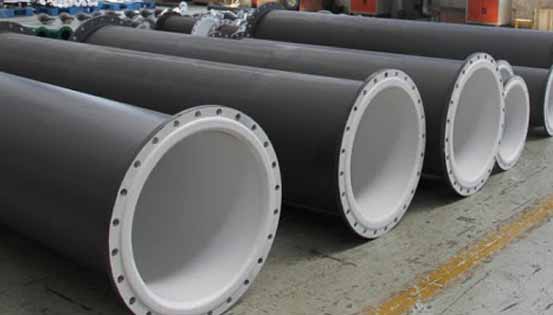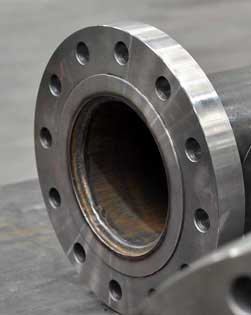27 October 2010- The entire process of rubber lining preparation involves the following five steps:
- Base surface preparation
- Rubber sheets preparation
- Rubber sheets application on the metal surface
- Vulcanization process
- Testing & Inspection process
Surface Preparation
This is very important process for rubber lining. It is to be noted the first thing that is required to prepare the metal surface is that it should be free from paint, oil, rust, dust etc. This is done using sand blasting or shot blasting. When the surface is cleaned, bonding agent or adhesive sealants are applied to surface. In the adhesion process, two or three coats are needed to be applied, as adhesion is an important process for rubber lining.Rubber Sheets Preparation
The synthetic rubber compound that is produced is as per the chemical and other conditions of the process. The sheets of rubber are made on calendar machine. The thickness varies. For more thickness, 2 or more layers are applied. Usually for pipe fittings, extruded rubber tubes are inserted in the pipes.Application of Rubber Sheets
The rubber sheets that are produced are applied on to the adhesive coated, half dried surface. This is done using slight pressure of hand or a metallic roll. Sometimes various lining tools are also used. While doing so, care must be taken not to trap air between the metal surface and rubber sheet. All joints are leveled and joined with help of knurling tools.

Vulcanization
In most cases, the vulcanization is done using an auto clave. In the process of vulcanization, rubber changes from plastic to elastic. The pressure and temperature depend upon the rubber compound and thickness of rubber lining. For equipments which are of large size, where rubber lining is done on site, vulcanization is done by open steam and also hot water curing. A specified temperature is maintained cure the rubber.Rubber Lining Preparation
Testing and Inspection
The rubber lining products are sent for testing. This testing is done before and after vulcanization so that they are free from faults. Any fault can cause failure of the equipment. In complete daylight, visual inspection is done to check mechanical damages blisters and poor joints. Also a spark test with a high voltage is carried out. This is done to check mechanical damages, blisters, holes, poor joints etc. For rubber lining, hardness test is an essential requirement. Knocking test is another test which is undertaken so as to test poor bonding.
Product Catalog
Industrial Applications
Industrial Rubber Products
Types of Synthetic Rubber
General Information
- Anti Vibration Mountings
- Automobile Rubber Products
- Calendered Rubber Products
- Extruded Rubber Products
- Medical Rubber Products
- Metal Bonded Components
- Rubber Adhesives & Sealants
- Rubber Ball
- Rubber Bands
- Rubber Beading
- Rubber Bearing
- Rubber Belt
- Rubber Buckets
- Rubber Bullets
- Rubber Cable
- Rubber Coating
- Rubber Duct
- Rubber Expansion Joints
- Rubber Flooring/Matting
- Rubber Footwear
- Rubber Gloves
- Rubber Injection Parts
- Rubber Lining
- Rubber Magnets
- Rubber Molded Products
- Rubber Pads
- Rubber Rollers
- Rubber Stopper
- Rubber Suit
- Rubber Track
- Rubber Valve
- Rubber Balloon
- Rubber Stamps
- Rubber Fenders
- Acrylic Rubber (ACM)
- Butadiene Rubber (BR)
- Butyl Rubber (IIR)
- Chlorosulfonated Polyethylene(CSM)/ Hypalon
- Ethylene Propylene Diene Monomer
- Fluoroelastomers (FKM)/Viton
- Isoprene Rubber (IR)
- Nitrile Rubber (NBR)
- Perfluoroelastomer (FFKM)
- Polychloroprene (CR)/Neoprene
- Polysulfide Rubber (PSR)
- Silicone Rubber (SiR)
- Styrene Butadiene Rubber
Featured Articles
How to Make a Custom Rubber Stamp?
Whenever designing a custom stamp for your company, never compromise on its quality because in the end it is the most...
Read MoreLatex and Silicone Rubber Tubing - A Comparison!
Many industries use rubber tubing for various purposes. In fact, various types of rubber tubing are used for different applications...
Read MoreSilicone vs Acrylic Adhesive- A Comparison
Silicon and acrylic adhesives are those rubber adhesives that are widely used in Polyimide tapes. In fact, the polyimide...
Read More
Copyright 2022 Industrial Rubber Goods All rights reserved.

